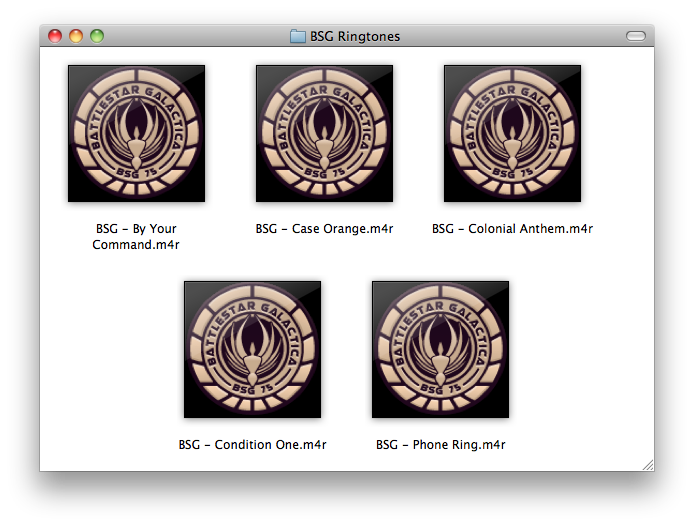My contribution for the DS106 assignment #3: WTF is Web 2.0?
WebTwoDotOh
I used clips from:
* [Groks Science Show](http://www.archive.org/details/groks197)
* [Kamla Bhatt’s interview with Tim O’Reilly](http://www.youtube.com/watch?v=CQibri7gpLM)
* [Dutch Thinktank EPN’s Web 1/2/3 video](http://www.youtube.com/watch?v=bsNcjya56v8&feature=related)
* [The Computer Chronicles: The Internet](http://www.archive.org/details/episode_1134)
* [Bags of Gold](http://abject.ca/bags-of-gold/)
* [Eric Schmidt on Web 2.0 vs. Web 3.0](http://www.youtube.com/watch?v=T0QJmmdw3b0)
The audio features the first ever public guitar playing of your humble author. I know it sucks. I figured I’d give it a shot, rather than trying to find some available music to play in the background to add some continuity between clips.
 OK. I’m a dork. I made some ringtones today to use on my iPhone, based on short clips from Battlestar Galactica. Maybe someone else will find them useful. Please don’t sue me. They were all made from very short sound clips I found online.
OK. I’m a dork. I made some ringtones today to use on my iPhone, based on short clips from Battlestar Galactica. Maybe someone else will find them useful. Please don’t sue me. They were all made from very short sound clips I found online.

I’m using “BSG – Phone Ring” as my ringtone (it’s the sound the telephones make on the ship) and the others are handy alarm notification sounds.
Download the ringtones
 I just spent a few minutes updating my podcast subscriptions – I haven’t really listened to podcasts for several months, and want to get back into more curated audio presentations, as opposed to the relentless randomness of Shuffle Mode music playlists.
I just spent a few minutes updating my podcast subscriptions – I haven’t really listened to podcasts for several months, and want to get back into more curated audio presentations, as opposed to the relentless randomness of Shuffle Mode music playlists.
I decided my previous set of subscriptions were essentially a self constructed echo chamber. I had subscribed to several edu-podcasts, all talking about various interpretations of the same issues. I need to break out of the echo chamber, so I unsubscribed from most of them (sorry – nothing personal). I added several music related podcasts, and a couple talk radio shows.
I’m not sure when I’ll have a chance to listen to them all, but I’m going to try. Perhaps as good background distraction while writing…
 I ordered a Samson CO1U USB “podcasting” microphone to use for my upcoming podcasting workshop. Brian has one, and it’s a beauty. Nice and heavy, and seems to have really nice and rich audio quality. Better than my little USB headset, Powerbook built-in mic, or iSight camera offer, anyway. It was cheap, too – under $80.
I ordered a Samson CO1U USB “podcasting” microphone to use for my upcoming podcasting workshop. Brian has one, and it’s a beauty. Nice and heavy, and seems to have really nice and rich audio quality. Better than my little USB headset, Powerbook built-in mic, or iSight camera offer, anyway. It was cheap, too – under $80.
After I opened the package, I plugged the USB cord into my G5. It was recognized right off the bat, and iChat and Garageband were able to use it with no additional installation. Then, I went ahead and installed the Samson “applet” to get additional tweakery and bitfiddlery.
Don’t install the applet. It also drops a kernel extension into your system, and requires a reboot. Sure, it gives you a cool-looking levels controller, but it also makes the microphone invisible to audio apps. I’d rather have a stock mic that works, thanks.
So, I uninstalled the .kext and rebooted to clear it out. The mic is visible again. But not to Audacity, for some reason. I’ll debug that tomorrow.
First reaction is: the mic (when it is recognized) sounds really nice. Is the flakeyness worth it? I’ll know more in a couple of days of playing…
 I ordered a Samson CO1U USB “podcasting” microphone to use for my upcoming podcasting workshop. Brian has one, and it’s a beauty. Nice and heavy, and seems to have really nice and rich audio quality. Better than my little USB headset, Powerbook built-in mic, or iSight camera offer, anyway. It was cheap, too – under $80.
I ordered a Samson CO1U USB “podcasting” microphone to use for my upcoming podcasting workshop. Brian has one, and it’s a beauty. Nice and heavy, and seems to have really nice and rich audio quality. Better than my little USB headset, Powerbook built-in mic, or iSight camera offer, anyway. It was cheap, too – under $80.
After I opened the package, I plugged the USB cord into my G5. It was recognized right off the bat, and iChat and Garageband were able to use it with no additional installation. Then, I went ahead and installed the Samson “applet” to get additional tweakery and bitfiddlery.
Don’t install the applet. It also drops a kernel extension into your system, and requires a reboot. Sure, it gives you a cool-looking levels controller, but it also makes the microphone invisible to audio apps. I’d rather have a stock mic that works, thanks.
So, I uninstalled the .kext and rebooted to clear it out. The mic is visible again. But not to Audacity, for some reason. I’ll debug that tomorrow.
First reaction is: the mic (when it is recognized) sounds really nice. Is the flakeyness worth it? I’ll know more in a couple of days of playing…
via Josie Fraser at EdTechUK – This is one of the cooler things I’ve seen in a while. Stanford University is putting a bunch of audio content online, free, via the iTMS.
Stanford on iTunes will provide alumni—as well as the general public—with a new and versatile way of staying connected to the university through downloads of faculty lectures, campus events, performances, book readings, music recorded by Stanford students and even podcasts of Stanford football games. At launch, the service will contain close to 400 distinct audio programs, and the university will continue to add new content as it becomes available.
They’ve put up a page describing the effort, with a direct link to the Stanford section of the iTMS. I’m downloading a few things now (a session on Stress and Coping – ironically enough – and some live recordings of some concerts).
Very cool. Great to see a Big School “get it” that by sharing resources freely they are not shooting themselves in the foot. Every university should be doing this as part of their contribution back to the community.
ps. Yes, I know it’s not really podcasting, but close enough. The spirit is the same, and they provide some handy hooks to download all content at once. So it’s not fed to you via RSS. Whatever…
via Josie Fraser at EdTechUK – This is one of the cooler things I’ve seen in a while. Stanford University is putting a bunch of audio content online, free, via the iTMS.
Stanford on iTunes will provide alumni—as well as the general public—with a new and versatile way of staying connected to the university through downloads of faculty lectures, campus events, performances, book readings, music recorded by Stanford students and even podcasts of Stanford football games. At launch, the service will contain close to 400 distinct audio programs, and the university will continue to add new content as it becomes available.
They’ve put up a page describing the effort, with a direct link to the Stanford section of the iTMS. I’m downloading a few things now (a session on Stress and Coping – ironically enough – and some live recordings of some concerts).
Very cool. Great to see a Big School “get it” that by sharing resources freely they are not shooting themselves in the foot. Every university should be doing this as part of their contribution back to the community.
ps. Yes, I know it’s not really podcasting, but close enough. The spirit is the same, and they provide some handy hooks to download all content at once. So it’s not fed to you via RSS. Whatever…


 I just spent a few minutes updating my podcast subscriptions – I haven’t really listened to podcasts for several months, and want to get back into more curated audio presentations, as opposed to the relentless randomness of Shuffle Mode music playlists.
I just spent a few minutes updating my podcast subscriptions – I haven’t really listened to podcasts for several months, and want to get back into more curated audio presentations, as opposed to the relentless randomness of Shuffle Mode music playlists.